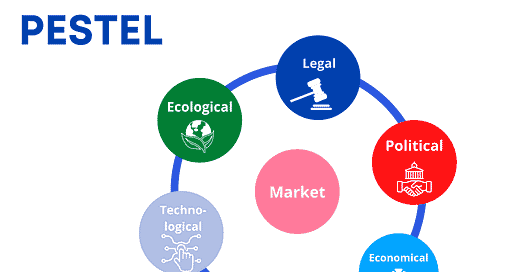What is PESTEL framework and how can it help you analyse your expansion plans?
If you are planning to expand your venture in a new territory, PESTEL is your friend! Analyse the environment in that foreign land, before you make a go/no-go decision
The PESTEL Framework: A Holistic Analysis of Business Environment
Greetings, aspiring business strategists! Today, we embark on an illuminating journey into the world of strategic analysis with the PESTEL framework. This tool, akin to a compass in uncharted business territory, offers a comprehensive view of the external factors that shape an organization's environment. Let's delve into the intricacies of PESTEL analysis, explore its six key categories, and uncover the profound insights it provides.
What is the PESTEL Framework?
The PESTEL framework, standing for Political, Economic, Social, Technological, Environmental, and Legal factors, serves as a strategic lens through which businesses assess the external environment's impact on their operations. Imagine a painter meticulously observing the colors and textures of a landscape before crafting a masterpiece. Similarly, PESTEL analysis enables businesses to decipher the nuances of their operating landscape before making informed decisions.
What should you look for, in each of these categories?
a) Political Factors: These encompass the influence of government policies, regulations, and political stability on a business. Consider how shifts in political leadership or changes in tax policies might impact operations. For example, in the pharmaceutical industry, changes in drug approval regulations can significantly affect a company's product development timelines.
b) Economic Factors: These involve economic conditions such as inflation rates, exchange rates, and economic growth. Examine how economic fluctuations might affect consumer purchasing power and market demand. For instance, during an economic downturn, luxury goods companies might experience reduced consumer spending.
c) Social Factors: Social trends, cultural norms, demographics, and consumer behavior fall under this category. Analyze shifts in consumer preferences and values, which can influence marketing strategies. A rise in health consciousness might prompt food and beverage companies to introduce healthier product lines.
d) Technological Factors: Technological advancements and innovations shape industries and markets. Evaluate how emerging technologies impact product development, production processes, and distribution channels. For example, the rise of e-commerce has transformed the retail landscape, leading traditional retailers to adapt their strategies.
e) Environmental Factors: These encompass ecological and environmental considerations, including sustainability, climate change, and natural resource availability. Organizations must assess their impact on the environment and respond to changing consumer demands for eco-friendly products. The automotive industry, for instance, faces pressure to develop electric and hybrid vehicles in response to environmental concerns.
f) Legal Factors: Legal factors encompass laws, regulations, and compliance requirements that affect a business's operations. Evaluate potential legal challenges, such as intellectual property rights, labor laws, and industry-specific regulations. In the tobacco industry, stringent regulations on advertising and packaging impact marketing strategies.
What conclusion can one draw from the PESTEL Analysis?
PESTEL analysis offers a panoramic snapshot of the external landscape, enabling businesses to identify opportunities and threats. By dissecting each category, an organization gains a nuanced understanding of potential challenges and advantages. It facilitates proactive decision-making, risk mitigation, and alignment of strategies with the prevailing environment. Armed with these insights, businesses can chart a course that leverages opportunities and mitigates risks, fostering adaptability and resilience.
How Can Marketers and Organizations Benefit from PESTEL analysis?
The benefits of PESTEL analysis are manifold, serving as a powerful compass for businesses:
a) Strategic Planning: Marketers can tailor their strategies by aligning them with prevailing political, economic, social, technological, environmental, and legal trends. For instance, a technology company can anticipate the impact of emerging technologies on consumer behavior and adjust its product offerings accordingly.
b) Risk Management: PESTEL analysis helps organizations anticipate and manage potential risks. By understanding legal and regulatory constraints, companies can avoid costly legal battles and compliance issues.
c) Innovation: Organizations can identify opportunities for innovation based on technological advancements and changing consumer preferences. An example is how ride-sharing companies capitalized on the proliferation of smartphones and the shift towards shared mobility.
d) Market Entry: PESTEL analysis assists businesses in evaluating the feasibility of entering new markets. By considering cultural nuances and legal frameworks, companies can make informed decisions about market entry strategies.
e) Adaptability: In an ever-evolving business landscape, PESTEL analysis equips organizations with the agility to respond to external changes promptly. This flexibility enables businesses to adjust their strategies and remain relevant.
In summary, the PESTEL framework is a multifaceted tool that empowers businesses to navigate the intricate external environment with wisdom and foresight. As you delve into strategic decision-making, remember that PESTEL analysis is your guiding star, ensuring that your business sails smoothly through the winds of change, seizing opportunities and minimizing risks along the way.
Intriguing Food for Thought
If you were Tesla, planning to expand to India, what all things would you look at from a PESTEL lens, to decide whether to go ahead or not? If yes, what would you change, in your strategy before you launch here?




![PESTEL analysis = Definition and Examples in USA [2023 ] PESTEL analysis = Definition and Examples in USA [2023 ]](https://substackcdn.com/image/fetch/$s_!Qkr8!,w_1456,c_limit,f_auto,q_auto:good,fl_progressive:steep/https%3A%2F%2Fsubstack-post-media.s3.amazonaws.com%2Fpublic%2Fimages%2F7620e082-7664-4c55-8a2a-0c252a663a32_2245x1587.png)